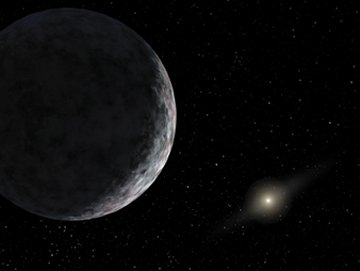Bigger than Pluto: Tenth planet or icy leftover?
Step aside, Pluto, there’s a new kid in town. Astronomers last week announced that they have detected a body larger and more distant than Pluto. It’s the biggest body found in the solar system since Neptune and its moon Triton were discovered in 1846. But whether the body, dubbed 2003 UB313, qualifies as our sun’s tenth known planet is a matter of intense debate.


Many astronomers, including codiscoverer Mike Brown of the California Institute of Technology in Pasadena, says that it’s a no-brainer—if Pluto is the ninth planet, then this object must be the tenth. But others argue that both Pluto and the newfound body, which are tiny compared with the other eight planets, are merely large members of the Kuiper belt, a reservoir containing thousands of icy leftovers from the solar system’s formation.
The debate began last week when Brown and his colleagues Chad Trujillo of the Gemini Observatory in Hilo, Hawaii, and David Rabinowitz of Yale University in New Haven, Conn., described the body in a July 29 circular of the International Astronomical Union. The team first found the object in October 2003 during a search for distant bodies in the solar system. For more than a year, the object remained just another data point. But early last January, a revised computer program flagged the object as notable: a slowly moving body that was brighter than other distant objects.
The slow motion indicated that the body resides far away, while the brightness suggested that it might be large. Images taken by the team on Jan. 8 with the 48-inch Samuel Oschin Telescope at Palomar Observatory near Escondido, Calif., showed that the object lies more than twice as far from the sun as Pluto does.
The infrared Spitzer Space Telescope failed to detect any heat from the body, indicating that it’s less than about 3,550 kilometers in diameter. However, the visible-light images revealed that it must be at least as large as Pluto. The team’s best estimate is that 2003 UB313 has a diameter about 1.5 times that of Pluto, which measures 2,300 km across.
Like Pluto, the object contains methane ice. Traveling around the sun in an elongated, 560-year orbit, it comes as close to the sun as 38 times the Earth-sun distance and strays as far as 97 times the Earth-sun separation. The orbit of 2003 UB313 shows an unusually large tilt, 44° relative to the plane in which most of the planets orbit the sun.
But is the object a planet? The body lies in the Kuiper belt and should be classified as a Kuiper resident, along with Pluto, asserts Brian Marsden of the Harvard-Smithsonian Center for Astrophysics in Cambridge, Mass. He notes that the large asteroid Ceres, discovered in 1801, was initially designated a planet, until a gaggle of rocky, asteroid belt objects was found in the same region. Similarly, the plethora of icy objects roaming the solar system’s outskirts should all be called Kuiper belt bodies, Marsden argues.







